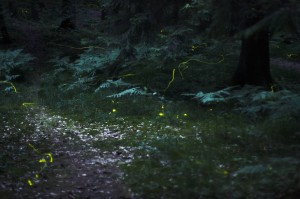 On a warm summer evening spent outside in the company of good friends and crickets one thing can’t be missing to get just the right atmosphere: The fireflies. Their bioluminescence magically creates a starry sky just above the surface of the earth. To be more exact, the enzyme luciferase activates the substance luciferin. The light emitting section of luciferin is dioxetane and it converts chemical energy into cold light by reaching its excited states through a conical intersection.
On a warm summer evening spent outside in the company of good friends and crickets one thing can’t be missing to get just the right atmosphere: The fireflies. Their bioluminescence magically creates a starry sky just above the surface of the earth. To be more exact, the enzyme luciferase activates the substance luciferin. The light emitting section of luciferin is dioxetane and it converts chemical energy into cold light by reaching its excited states through a conical intersection.
Loren Greenman and David Mazziotti recently studied dioxetanone by means of quantum chemical methods. They argue that the anti-Hermitian contracted Schrodinger equation describes both, dynamic and static electron correlation, and that this method is sufficiently accurate to describe the region close to the conical intersection of dioxetanone where strong correlation has to be taken into account.
So, next time you spend one of these splendid summer evenings outside, let yourself be enlightened by the fireflies to find the ultimate solution to the electron correlation problem in quantum chemistry.
— Leonie Mueck
Read more:
L. Greenman, D. Mazziotti, “Balancing single- and multi-reference correlation in the chemiluminescent reaction of dioxetanone using the anti-Hermitian contracted Schroedinger equation”, Journal of Chemical Physics, 134, 174110 (2011)
L. Greenman, D. Mazziotti, Strong electron correlation in the decomposition reaction of dioxetanone with implications for firefly bioluminescence, Journal of Chemical Physics, 133, 164110 (2010)
Picture: Fireflies in the wood, exposure time 30 seconds, http://en.wikipedia.org/wiki/File:GluehwuermchenImWald.jpg